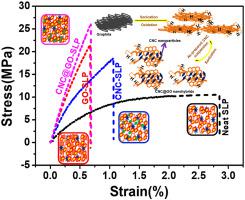Composites Part B: Engineering ( IF 12.7 ) Pub Date : 2022-04-19 , DOI: 10.1016/j.compositesb.2022.109918
Duraisami Dhamodharan 1 , Veeman Dhinakaran 2 , Pradnya NP. Ghoderao 1 , Hun-Soo Byun 1 , Lixin Wu 3

|
The solution mixing approach-based cellulose nanocrystals (CNCs) decorated graphene oxide (GO) nanohybrids (CNC@GO) was prepared and their effect over on the solventless polymer (SLP) called waterborne epoxy system was analyzed. The as-prepared GO, CNC and CNC@GO were scrutinized by several characterization techniques such as X-ray diffraction (XRD), thermogravimetric analysis (TGA), Raman Analysis, Fourier transform infra-red (FT-IR), transmission electron microscopy (TEM) and field emission scanning electron microscope (FESEM) for identifying their quality. The GO-SLP, CNC-SLP and CNC@GO-SLP nanocomposites mechanical and thermal properties were analyzed in detail. The highest tensile strength was observed at the lowest loading content (0.2 wt %) of CNC@GO incorporated SLP nanocomposites, as compared with other (0.2 wt % of (GO-SLP and CNC-SLP)) nanocomposites. Also, the thermo-mechanical analysis of CNC@GO nanohybrids incorporated SLP system exposes a notable improvement in the tan delta and storage modulus values at lower nanofiller concentration (0.2 wt %). The successful decoration of CNC on the GO surface promotes to the uniform dispersion, strong hydrogen bonding and outstanding interaction between the introduced nanofillers within the SLP system which leads to the better results in the mechanical and thermal properties. Besides, it was observed that the numerical simulation responses were in good deal with the laboratory values for both ultimate stress and strain. Thus, the as-prepared nanohybrids could possibly enrich the mechanical and thermal properties of the SLP system.
中文翻译:

纤维素纳米晶体-氧化石墨烯作为有效纳米填料增强无溶剂聚合物纳米复合材料性能的协同效应
制备了基于溶液混合方法的纤维素纳米晶体 (CNCs) 修饰的氧化石墨烯 (GO) 纳米杂化物 (CNC@GO),并分析了它们对称为水性环氧体系的无溶剂聚合物 (SLP) 的影响。所制备的 GO、CNC 和 CNC@GO 通过 X 射线衍射 (XRD)、热重分析 (TGA)、拉曼分析、傅里叶变换红外 (FT-IR)、透射电子显微镜等多种表征技术进行了仔细检查(TEM) 和场发射扫描电子显微镜 (FESEM) 来识别它们的质量。详细分析了 GO-SLP、CNC-SLP 和 CNC@GO-SLP 纳米复合材料的机械和热性能。与其他 (0. 2 wt%(GO-SLP 和 CNC-SLP))纳米复合材料。此外,结合了 SLP 系统的 CNC@GO 纳米杂化物的热机械分析表明,在较低的纳米填料浓度(0.2 wt%)下,tan delta 和储能模量值有显着改善。CNC在GO表面的成功修饰促进了SLP系统中引入的纳米填料之间的均匀分散、强氢键和出色的相互作用,从而获得更好的机械和热性能。此外,观察到数值模拟响应与极限应力和应变的实验室值非常吻合。因此,所制备的纳米杂化物可能会丰富 SLP 系统的机械和热性能。CNC@GO nanohybrids 并入 SLP 系统的热机械分析表明,在较低的纳米填料浓度(0.2 wt%)下,tan delta 和储能模量值有显着改善。CNC在GO表面的成功修饰促进了SLP系统中引入的纳米填料之间的均匀分散、强氢键和出色的相互作用,从而获得更好的机械和热性能。此外,观察到数值模拟响应与极限应力和应变的实验室值非常吻合。因此,所制备的纳米杂化物可能会丰富 SLP 系统的机械和热性能。CNC@GO nanohybrids 并入 SLP 系统的热机械分析表明,在较低的纳米填料浓度(0.2 wt%)下,tan delta 和储能模量值有显着改善。CNC在GO表面的成功修饰促进了SLP系统中引入的纳米填料之间的均匀分散、强氢键和出色的相互作用,从而获得更好的机械和热性能。此外,观察到数值模拟响应与极限应力和应变的实验室值非常吻合。因此,所制备的纳米杂化物可能会丰富 SLP 系统的机械和热性能。2 重量%)。CNC在GO表面的成功修饰促进了SLP系统中引入的纳米填料之间的均匀分散、强氢键和出色的相互作用,从而获得更好的机械和热性能。此外,观察到数值模拟响应与极限应力和应变的实验室值非常吻合。因此,所制备的纳米杂化物可能会丰富 SLP 系统的机械和热性能。2 重量%)。CNC在GO表面的成功修饰促进了SLP系统中引入的纳米填料之间的均匀分散、强氢键和出色的相互作用,从而获得更好的机械和热性能。此外,观察到数值模拟响应与极限应力和应变的实验室值非常吻合。因此,所制备的纳米杂化物可能会丰富 SLP 系统的机械和热性能。据观察,数值模拟响应与极限应力和应变的实验室值非常吻合。因此,所制备的纳米杂化物可能会丰富 SLP 系统的机械和热性能。据观察,数值模拟响应与极限应力和应变的实验室值非常吻合。因此,所制备的纳米杂化物可能会丰富 SLP 系统的机械和热性能。

































 京公网安备 11010802027423号
京公网安备 11010802027423号